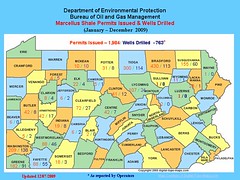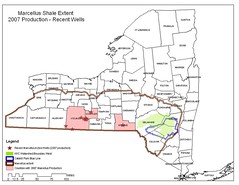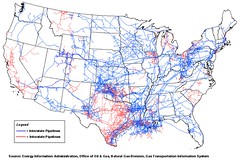Hopefully, being informed will help us make the right decisions about energy and the environment, and press our senators and representatives to legislate in favor of protecting our vital, lifeline resources: air, land and water! WRITE NOW!!! (See sidebar at left.)
Alice Joyce
SOTT.net
Mon, 24 Aug 2009 18:22 UTC
If you had a choice between filling your car of the future with natural gas (now being promoted as a viable, green, clean, future alternative to oil), or quenching your thirst with unpolluted water which would you choose? This is not a hypothetical question. If the natural gas lobby continues to have its way, natural gas - the supposed safe, ecologically friendly fuel source - may do some serious damage to the earth's water.
In 2002 advances in horizontal drilling (a technology invented by Halliburton in 1949), drastically reduced the costs previously required to extract natural gas from rock and shale located miles deep within the earth. Although the industry asserts that the process is safe, does the following industry summary from a Halliburton January 17, the following found on slide 65 of its 2008 power point presentation entitled A Historic Perspective of Hydraulic Fracturing inspire confidence?
After 60 years of hydraulic fracturing research technology and experience, we can safely say that we know about hydraulically created fracturesAnd does this promotional video distributed by Baker Hughes, a competitor of Halliburton, which presents as an advantage of its technology the need for fewer highly trained technicians to be on site allay concerns about industry commitments to the safety of the general public?
EXCEPTOther than that, we've got it down pat!
- How Deeply They Penetrate
- Their Vertical Extents
- Their Symmetries About the Wellbore
- Whether They are Planar or Multistranded
- Their geometries at the Perimeter
- Which Directions They Go
- What Their Conductivities are
But they still make a lot of money
HYDRAULIC FRACTURING; GO FOR IT!
Horizontal drilling involves numerous lateral wells which branch off from a main shaft drilled up to 10 miles into the earth. Each well is then injected with several millions of gallons of water and sand under high pressure to create fissures that fracture or "frack" the rock in which the gas is trapped. Unfortunately, while the process does liberate gas from the rock it is trapped within, it also infuses the millions of gallons of water that free it with the ingredients of a chemical cocktail which energy companies insist is safe while refusing to release data concerning its contents. The secrecy, they say, is necessary to protect company proprietary rights to the formula from being copied by competitors, not to cover up any health risks to the public.
Lending credibility to the industry's reassurances is a 2004 EPA study whose conclusion ruled that the fluids used in the fracking process are without risk. However, the concerted efforts of then Vice President Dick Cheney and energy lobbyists to weaken environmental regulations in the 2005 Energy Bill the following year does raise some red flags.
If the EPA's 2004 ruling was accurate, why did Dick Cheney and energy lobbyists feel the need to push through amendments to the 2005 Energy Bill that gave energy companies exemptions from The Clean Air Act, The Safe Drinking Water Act, The National Environmental Policy Act, The Comprehensive Environmental Recovery, The Compensation and Liability Act, The Resource Conservation and Recovery Act, and The Toxic Release Inventory under the Emergency Planning and Community Right-to-know Act?
Was there something that Cheney and the lobbyists knew that they wanted to keep hidden from the rest of us?
Click here to read an excerpt of an interview with Wes Wilson, an environmental engineer and 30 year employee of the EPA who requested whistleblower protection, submitted an 18 page document to members of Congress and the EPA's Inspector General which claimed that the study was inaccurate, that the fluids posed health risks, and that the report was written by a panel linked to the industry that included an employee of Halliburton.
... despite the concerns raised in the 2004 EPA Report, The 2005 Energy Bill was passed by an overwhelming majority.
On August 8, 2005, President Bush signed into the law the energy bill; on July 28, the U.S. House of Representatives voted 275 to 156 to approve the energy bill; and on July 29, the U.S. Senate voted 74 to 26 to approve the energy bill which was in large part written by the industry.Sixteen companies spent $70 million lobbying Congress and $15 million in donations given to federal candidates - most of it going to Republican politicians. PublicCitizen identifies these companies as:
Anadarko, BP, Burlington Resources, ChevronTexaco, ConocoPhillips, Devon Energy, Dominion Resources, EOG Resources, Evergreen Resources, Halliburton, Marathon Oil, Oxbow (Gunnison Energy), Tom Brown, Western Gas Resources, Williams Cos and XTO.The implications of passage of these amendments on the environment is evident in the following analysis of the effects the exemptions from the Safe Drinking Water Act would have on the integrity of the water supply.
Oil and Gas Regulatory RollbacksThe victory for the energy companies proved to be disastrous for those affected by it. Since publicizing the ingredients in proprietary leases is not mandated by law, the public has had no recourse for mandating that energy companies release the contents of their fracking fluids.
Section 322 exempts from the Safe Drinking Water Act a coalbed methane drilling technique called "hydraulic fracturing," a potential polluter of underground drinking water. One of the largest companies employing this technique is Halliburton, for which Vice President Richard Cheney acted as chief executive officer in the 1990s.
This exemption would kill lawsuits by Western ranchers who say that drilling for methane gas pollutes groundwater by injecting contaminated fluids underground
Despite this lack of transparency TEDX (The Endocrine Disruption Exchange) has compiled an incomplete list of the names of products and their chemicals indirectly from industry Material Safety Sheets, state Emergency Planning and Community-Right-To-Know, (EPCRA), Tier II Reports, Environmental Impact Statement and Environmental Assessment Statement disclosures, rule-making documents and accident and spill reports which can be viewed here.
As more communities experienced adverse effects from horizontal drilling, there have been calls to regulate the industry. Ironically, in an Orwellian twisting of the truth, the industry counters by arguing that the EPA 2004 report, (which we have already seen was heavily influenced by the industry), is proof enough that the process is safe and needs no regulation.
This argument is used in the industry website Energy in Depth to refute The Center for American Progress's (CAP) demands for legislation revealing the ingredients of fracking fluids.
Calling CAP "an influential, left-of-center public policy organization based in Washington, D.C.", and describing its support of The Frac Act of 2009 as support for "legislation that seeks to impede the development of America's abundant shale gas resources by targeting the critical tools needed to bring those resources to market," Energy in Depth goes on to refute the need for regulation by citing the 2004 EPA report:
In 2004, no less an authority than the EPA itself undertook an exhaustive research project aimed at finding out, once and for all, whether hydraulic fracturing posed a legitimate risk to ground and drinking water. It found "no evidence" of any such risk.Instead, a rosy picture of job creation, millions of dollars in revenue for states and municipalities, and the continued availability of safe water which defies all fact and experience is used to convince lawmakers already desperate for funds in this worsening recession that horizontal drilling is just what is needed to bring the economic relief they need.
...
In addition to the mysterious illnesses that just happen to break out in areas which have been exposed to fracking fluids, is the phenomenon of sudden explosions which also occur in areas that have been recently drilled. These explosions are significant in that they directly relate to the contamination of the water supply by the leakage of methane gas into wells and aquifers.
Buried Secrets: Is Natural Gas Drilling Endangering U.S. Water Supplies?
In December 2007, a house in Bainbridge, Ohio exploded in a fiery ball. Investigators discovered that the neighborhood's tap water contained so much methane that the house ignited. A study released this month concluded that pressure caused by hydraulic fracturing pushed the gas, which is found naturally thousands of feet below, through a system of cracks into the groundwater aquifer.Other concerns are the corruption of the integrity of watersheds and other water sources. The plan to drill in the Marcellus Shale Formation in upstate New York threatens the watershed which supplies pure, unfiltered water to 10 million New York City residents as well as water to farmers and other residents of the state.
Despite safety assurances for the chemicals used in the fracturing fluids, there have been reports of animal deaths near drilling sites using such fluid.
There have also been reports of sinkholes developing on drilling sites. In Denver City, a sinkhole suddenly appeared on a drilling site owned by Occidental Permian Limited which measured 76 feet by 70 feet and was 48 feet deep.
Perhaps the most dramatic example of gas drilling gone awry is the mud volcano that erupted on the island of Java, Indonesia. The mud began to erupt in 2006 following an exploratory drilling procedure, and it hasn't stopped since. Experts are 99% sure that the eruption was caused by drilling.
The mud continues to erupt and flow at a rate of about 100,000 cubic meters a day. There is no way that experts can predict when or where these eruptions will next occur. Some of them have even taken place in people's living rooms!
To make this story even more bizarre, and to add to its horror movie quality, it is estimated that the mud will continue to flow for at least another 30 years!
Here is a Time video that gives a sense of the magnitude of the catastrophe:
In the frenzy that has been generated around the media-generated energy crisis raising fears that we will run out of fossil fuels, we seem to have lost our perspective about which resources are truly necessary to sustain life. Clean air, healthy soil, and of course uncontaminated water are elements upon which all life depends. Generations have lived without fossil fuels, but none have lived without air, soil, and water. These resources must not be allowed to devolve into commodities, for if they do, those who provide them will have the power of life and death over all living things.
For the complete article, CLICK HERE.



















No comments:
Post a Comment